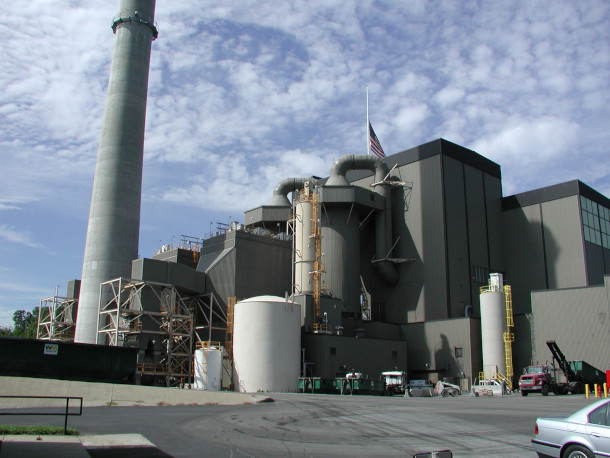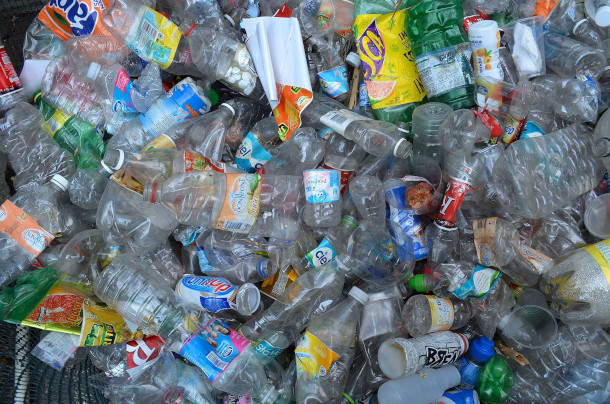Plastic Burning Pollution Flies Under the Radar
Air Date: Week of May 5, 2023

Municipal incinerators in the US are currently exempt from regulations requiring facilities that release toxic chemicals to report those outputs to the Toxics Release Inventory. (Photo: Massachusetts Dept. of Environmental Protection, Flickr, CC BY 2.0)
Waste incineration facilities in the US don’t have to report the dioxins and other toxic chemicals they’re emitting from burning plastic to a key database. Timothy Whitehouse is the Executive Director of Public Employees for Environmental Responsibility and joins Host Jenni Doering to explain the gap in publicly accessible pollution data.
Transcript
DOERING: Just 5 percent of plastic waste is recycled in the U.S. each year. Of the other 95 percent, some winds up as pollution in the ocean, most is buried in landfills and roughly 10% is burned, generating harmful air pollutants like dioxins and ash containing heavy metals. But waste incineration facilities don’t actually have to report the toxic chemicals they’re emitting from burning plastic waste. Advocates with Public Employees for Environmental Responsibility, or PEER, and Energy Justice Network are petitioning the Environmental Protection Agency to change that. Timothy Whitehouse is the executive director of PEER and he joins me now. Welcome to Living on Earth!
WHITEHOUSE: Thank you. It's good to be here.
DOERING: So I was frankly kind of shocked, honestly, to learn that incinerators aren't actually required to report their toxic chemical emissions. Why is that?
WHITEHOUSE: That's a great question. No one's quite sure why they got exempted, probably political power. But we do know that incinerators uh release some of the most toxic pollutants known to mankind, and are often some of the most egregious polluters in the states and counties where they're located.
DOERING: So when we're talking about waste incineration, what types of waste are being incinerated?
WHITEHOUSE: So there are different kinds of incinerators. The most common that people are familiar with are municipal waste combustors or trash incinerators. So there are about 68 of these in the United States. They combust things that you throw on your garbage, it can be food waste, it can be paper, it can be couches, carpets, plastics, light bulbs, Inc. They're also hospital and medical and infectious waste incinerators. There are also sewage sludge incinerators that incinerate sewage sludge from our waste treatment plants. And there are a type of incinerators called pyrolysis. And those are incinerators that take plastics and convert them into different chemicals and gases.
DOERING: So what kinds of toxic chemicals can be released from burning those kinds of things?
WHITEHOUSE: Yes, so it's well-known that incinerators release cancer-causing chemicals. They release chemicals that induce asthma. They release chemicals that weaken our immune systems. These have been well documented by studies throughout the United States and the world. Some of the more common chemicals that people know of are lead, or mercury. There's also a toxic class of chemicals that people are becoming familiar with, called PFAS. And those are a class of chemicals that number in the 1000s and EPA requires 180 of these different PFAS to be reported as part of a toxic release inventory. There are dioxins, which are cancer-causing pollutants that are released when things are incinerated. And we know that municipal waste incinerators, the really big ones, and the bad ones, and the ones that produce the most toxic chemicals are located in low income and communities of color throughout the United States.
DOERING: So your petition to the EPA, along with the Energy Justice Network, is attempting to require these types of emissions from waste incineration to be reported to the TRI the Toxic Release Inventory. What do you hope that that would achieve?

Chemical recycling companies claim that they recycle plastic, but their process typically involves burning it, releasing toxins in the process. (Photo: Celinebj, Wikimedia Commons, CC BY-SA 4.0)
WHITEHOUSE: There's a couple of things that we hope that would achieve. The basic purpose of TRI is to allow local, state, and federal governments, and emergency responders to know what chemicals are being stored and released into the water, air, and surrounding environments in their communities. And this allows the better management of these wastes. And this allows for an accurate comparison of how dangerous different facilities are, and whether greater regulations are needed of these facilities. If you don't know what these facilities are releasing, it's very hard to develop good regulations to address those releases. The bottom line is if an industry is releasing toxic materials covered by the Toxic Release Inventory, they should be required to report to the Toxic Release Inventory, no exceptions. Toxic chemicals affect the public the same way whether it's coming from an oil and gas facility, or an incinerator, or a plastics-to-energy plant. From a human health perspective, from an environmental perspective, the source of the pollution doesn't matter. So the issue should be very clear and very simple. Incinerators are a major source of toxic air pollution, but they don't need to report to the TRI.
DOERING: So Tim, I can't help but think that, you know, EPA has been around for over 50 years. And these facilities have been around for many decades as well. Have there been other attempts to you know, get these chemicals to be reported? And if so, like, why are you having to bring this action now?
WHITEHOUSE: So incinerators are required to report different releases of chemicals into various government databases, but they're not as extensive as the TRI, and they're almost inaccessible to the public. The great thing about the TRI is if you have basic computer skills, you can understand what is being released into your environment from local facilities that are required to report to the TRI. It is one of the great triumphs of EPA's transparency work. And incinerators have managed to stay out of that system. And it's very unfortunate.
DOERING: So it sounds like it's as much about public awareness as anything else here.
WHITEHOUSE: It's about public awareness. Also, the other thing I want to point out is, a lot of these incinerators produce energy. So they either produce energy in the form of electricity, or increasingly, they're creating energy in the form of creating new fuels. And so this industry is claiming it's clean and green. And it's asking for federal subsidies. And it's asking for state subsidies as a clean energy source. But at the same time, they're refusing to report their toxic release emissions to the TRI.

Exposure to air pollutants, including those from incinerators, increases the risk of diseases like cancer and asthma. (Photo: cottonbro studio, pexels, CC)
DOERING: Now it sounds like you're referring to facilities involved in so-called advanced recycling or chemical recycling of plastics when you talk about these facilities that produce fuel. Is that correct?
WHITEHOUSE: Yes, correct. That's called pyrolysis.
DOERING: Yes. So these are currently considered incineration facilities by the EPA. But I understand that the Trump administration proposed a rule that would actually deregulate these facilities by moving them out of this incineration category. And right now the Biden administration is reconsidering those rules. And they're kind of stuck in this evaluation stage. What are you hearing from within the EPA about these proposed rules?
WHITEHOUSE: So unfortunately, it appears that this EPA is considering the Trump-era proposed rules to remove these plants from section 129 of the Clean Air Act. And if they are able to remove these types of plants from the Clean Air Act, from section 129, there'll be virtually no air regulations over these types of facilities. We know that these types of facilities release some of the most toxic pollutants into the environment known to humankind. They are considering this proposal quite seriously, I believe, because there is this huge push for what's called advanced recycling, which in my mind, is locking us into a toxic carbon-based lifestyle that will wreck the climate and poison us in the wildlife around us.
DOERING: Now, from what I've been able to see this rule, it's murky, right? It's hard to see what's actually going on within EPA because they opened up a public comment period in late 2021. And, from what I've seen, they haven't released anything else publicly beyond that. But what are you hearing about where EPA might go with this at this point,
WHITEHOUSE: It's hard to know where EPA wants to go with this. But we do know from their approval of some of the chemicals that are being produced by these plants, that the direction is very troubling. For example, EPA recently approved a chemical produced from one of these plants that has a risk of one in four people being exposed to this chemical could get cancer over their lifetime. And that's an EPA assessment. That is 250,000 times greater than what EPA would normally approve. And so EPA is cutting corners to accommodate the oil and gas and chemical industry that is behind this effort. And they're doing it largely in secret. So most of the work that EPA is doing in approving these chemicals, is done behind closed doors and done under the guise of confidential business information. So we are very concerned about how EPA will approach the management and regulation of these plants that basically heat and burn plastic incinerate plastics to create new fuels.
DOERING: Tim Whitehouse is the executive director of Public Employees for Environmental Responsibility, or PEER. Thank you so much, Tim.
WHITEHOUSE: Thank you.
DOERING: We reached out to EPA about its consideration of the Trump-era proposal to de-regulate so-called “chemical recycling” plants. A spokesperson wrote, “EPA is currently reviewing the comments and input from stakeholders on the advanced notice of proposed rulemaking.” A full statement is on the Living on Earth website, LOE.org.
Links
More about the Energy Justice Network
Living on Earth wants to hear from you!
Living on Earth
62 Calef Highway, Suite 212
Lee, NH 03861
Telephone: 617-287-4121
E-mail: comments@loe.org
Newsletter [Click here]
Donate to Living on Earth!
Living on Earth is an independent media program and relies entirely on contributions from listeners and institutions supporting public service. Please donate now to preserve an independent environmental voice.
NewsletterLiving on Earth offers a weekly delivery of the show's rundown to your mailbox. Sign up for our newsletter today!
 Sailors For The Sea: Be the change you want to sea.
Sailors For The Sea: Be the change you want to sea.
 The Grantham Foundation for the Protection of the Environment: Committed to protecting and improving the health of the global environment.
The Grantham Foundation for the Protection of the Environment: Committed to protecting and improving the health of the global environment.
 Contribute to Living on Earth and receive, as our gift to you, an archival print of one of Mark Seth Lender's extraordinary wildlife photographs. Follow the link to see Mark's current collection of photographs.
Contribute to Living on Earth and receive, as our gift to you, an archival print of one of Mark Seth Lender's extraordinary wildlife photographs. Follow the link to see Mark's current collection of photographs.
 Buy a signed copy of Mark Seth Lender's book Smeagull the Seagull & support Living on Earth
Buy a signed copy of Mark Seth Lender's book Smeagull the Seagull & support Living on Earth

